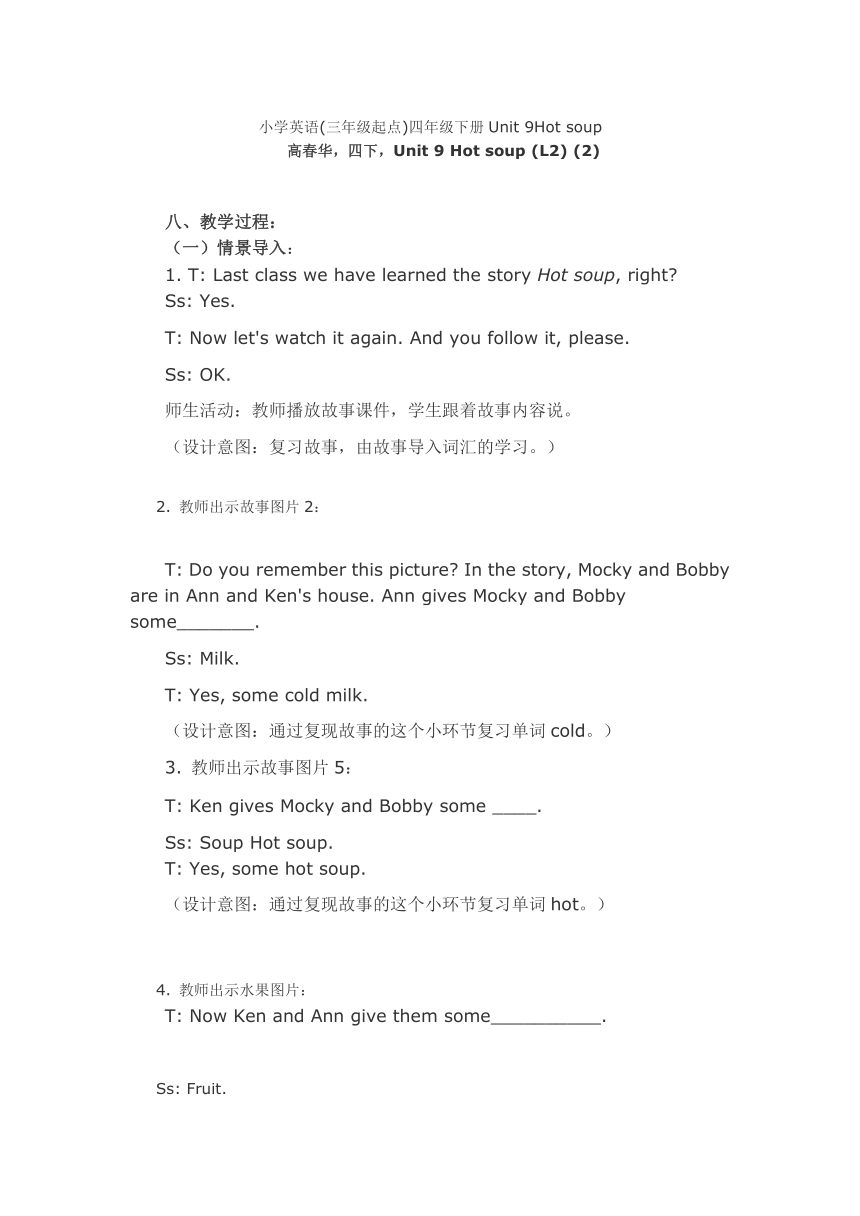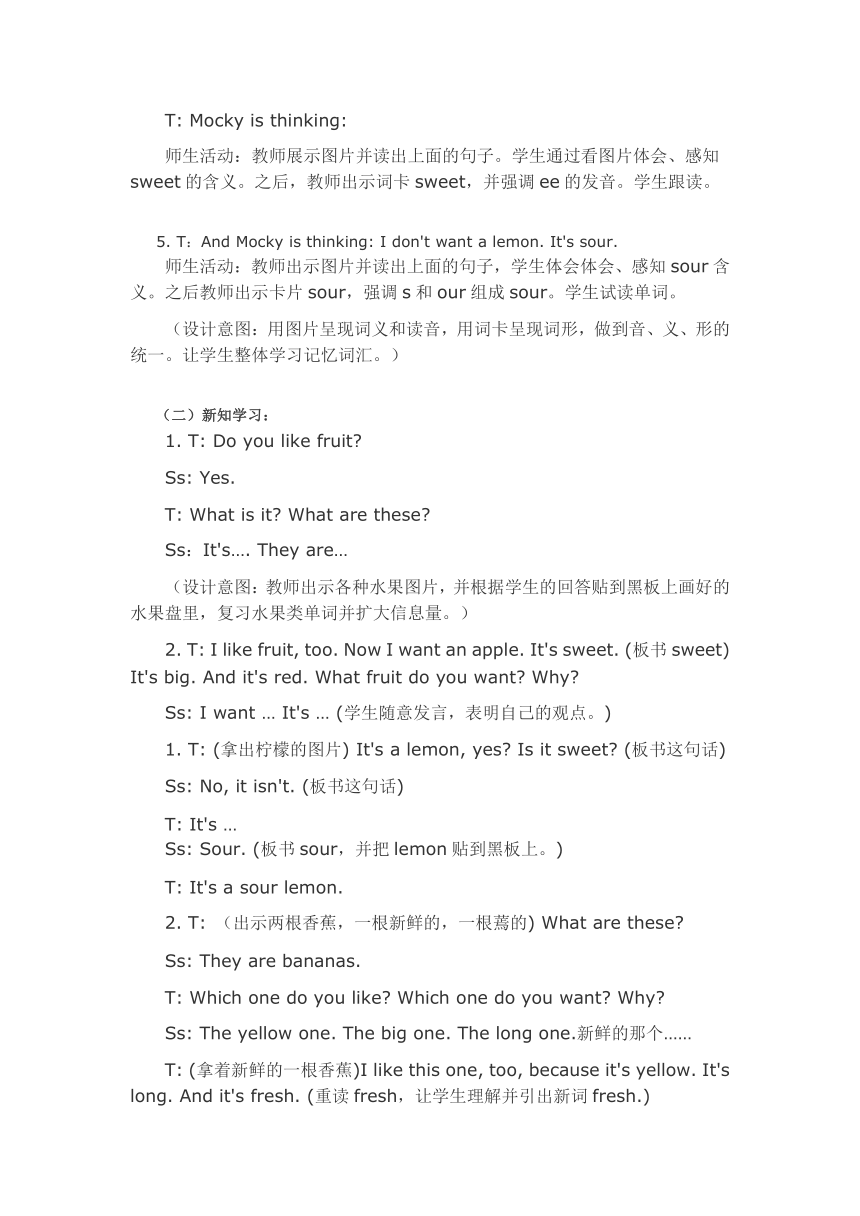小学英语北师大版(三年级起点四年级下册UNIT9 hot soup 教案
文档属性
| 名称 | 小学英语北师大版(三年级起点四年级下册UNIT9 hot soup 教案 |  | |
| 格式 | zip | ||
| 文件大小 | 13.3KB | ||
| 资源类型 | 教案 | ||
| 版本资源 | 北师大版(三年级起点) | ||
| 科目 | 英语 | ||
| 更新时间 | 2014-03-29 17:29:46 | ||
图片预览


文档简介
小学英语(三年级起点)四年级下册Unit 9Hot soup
高春华,四下,Unit 9 Hot soup (L2) (2)
八、教学过程:
(一)情景导入:
1. T: Last class we have learned the story Hot soup, right
Ss: Yes.
T: Now let's watch it again. And you follow it, please.
Ss: OK.
师生活动:教师播放故事课件,学生跟着故事内容说。
(设计意图:复习故事,由故事导入词汇的学习。)
2. 教师出示故事图片2:
T: Do you remember this picture In the story, Mocky and Bobby are in Ann and Ken's house. Ann gives Mocky and Bobby some_______.
Ss: Milk.
T: Yes, some cold milk.
(设计意图:通过复现故事的这个小环节复习单词cold。)
3. 教师出示故事图片5:
T: Ken gives Mocky and Bobby some ____.
Ss: Soup Hot soup.
T: Yes, some hot soup.
(设计意图:通过复现故事的这个小环节复习单词hot。)
4. 教师出示水果图片:
T: Now Ken and Ann give them some__________.
Ss: Fruit.
T: Mocky is thinking:
师生活动:教师展示图片并读出上面的句子。学生通过看图片体会、感知sweet的含义。之后,教师出示词卡sweet,并强调ee的发音。学生跟读。
5. T:And Mocky is thinking: I don't want a lemon. It's sour.
师生活动:教师出示图片并读出上面的句子,学生体会体会、感知sour含义。之后教师出示卡片sour,强调s和our组成sour。学生试读单词。
(设计意图:用图片呈现词义和读音,用词卡呈现词形,做到音、义、形的统一。让学生整体学习记忆词汇。)
(二)新知学习:
1. T: Do you like fruit
Ss: Yes.
T: What is it What are these
Ss:It's…. They are…
(设计意图:教师出示各种水果图片,并根据学生的回答贴到黑板上画好的水果盘里,复习水果类单词并扩大信息量。)
2. T: I like fruit, too. Now I want an apple. It's sweet. (板书sweet) It's big. And it's red. What fruit do you want Why
Ss: I want … It's … (学生随意发言,表明自己的观点。)
1. T: (拿出柠檬的图片) It's a lemon, yes Is it sweet (板书这句话)
Ss: No, it isn't. (板书这句话)
T: It's …
Ss: Sour. (板书sour,并把lemon贴到黑板上。)
T: It's a sour lemon.
2. T: (出示两根香蕉,一根新鲜的,一根蔫的) What are these
Ss: They are bananas.
T: Which one do you like Which one do you want Why
Ss: The yellow one. The big one. The long one.新鲜的那个……
T: (拿着新鲜的一根香蕉)I like this one, too, because it's yellow. It's long. And it's fresh. (重读fresh,让学生理解并引出新词fresh.)
T: (拿出两个苹果,一个新鲜的,一个蔫的) Which one do you want (拿蔫的问)This one (拿新鲜的问)This one
Ss: (看着蔫苹果)No. (看着新鲜的苹果)Yes.
T:(拿着新鲜的苹果,带着学生说)It's big. It's red. It's sweet. And it's fresh. (在水果盘上方板书fresh,并出示卡片fresh,让学生读。)
3. T: (指着板书上的水果盘) Look at the fruit, they are all fresh. We should say: I want some fresh fruit. (教师板书I want some fresh fruit.)
Ss: I want some fresh fruit.
(设计意图:在情景中学习词汇,并能够学用结合。适时渗透德育:在生活中多吃新鲜的水果有益健康。)
(三)操练新知:
1. T: Can you say some other sour or sweet fruit
Ss: The kiwi fruit is sweet.The …
2. T: Can you say some other sour or sweet food
Ss: Sour and hot soup Yogurt is sour....
(设计意图:拓展生活中的水果、食物哪些是酸的或甜的,发散学生的思维去联想身边的事物并应用。)
3. T: Now I have some delicious food, fruit and drink for you. Let's see what they are.
(教师出示words to Learn 部分,学生重复“Words to Learn”中的内容。)
4. T: (电脑上出示Words to Learn完整的图片)What do you want
Ss: I want some hot soup.I want a cold ice cream....
5. T: Do you remember a (电脑出示a)
Ss: a sour lemona sweet orange a cold ice cream.
T: Do you remember some (电脑出示some)
Ss: some…
6. 教师用电脑出示左下图,布置任务:根据a 和some给短语分类。学生完成任务后参照右下图核对答案并朗读。
(设计意图:用探究、归类方法感知体会a和some 的用法。)
7. 处理Listen to This。
(1) 预测图片。
T: Can you say something about the pictures
Ss: Some hot soup… (学生有的能说完整的句子,有的能说一些词组。)
(2) 完成听音标号的任务。
(3) 核对答案并描述图片。
T: Which picture is Number One Can you tell me the sentence
Ss: Picture F is Number One. The milk is cold.
…
(四)巩固发展新知:
1. Play a guessing game.
师生活动:根据教师提供的形容词yellowbigsmallcoldhotsweetsourfresh等,学生用Is it… 句型猜水果、蔬菜和饮料。
例如:
S1: Is it sour
T: Yes, it is.
S2: Is it yellow
T: Yes, it is.
S3: Is it a lemon
T: Yes, it is.
…
(设计意图:通过游戏情境让学生应用所学词汇和句型,促进知识的内化吸收。)
2. 学生自主选择一幅图进行对话表演。蓝色字体部分为学生的表达提供语言支持。
T: Where are they T: Who are they
At the zoo At the restaurant Ss: They are Ann, Mocky and Bobby.
At the fruit shop
Ss: They are at the fruit shop. T: Where are they
T: What are they talking about Ss: They are at home.
(设计意图:在提供的做客、买东西的情景中,运用所学的形容词对水果、食物的主要特征进行描述,强调对语言的应用。)
(五)Homework:
Draw some food and write:
E.g. I like sweet watermelon.
I don't like sour lemon.
高春华,四下,Unit 9 Hot soup (L2) (2)
八、教学过程:
(一)情景导入:
1. T: Last class we have learned the story Hot soup, right
Ss: Yes.
T: Now let's watch it again. And you follow it, please.
Ss: OK.
师生活动:教师播放故事课件,学生跟着故事内容说。
(设计意图:复习故事,由故事导入词汇的学习。)
2. 教师出示故事图片2:
T: Do you remember this picture In the story, Mocky and Bobby are in Ann and Ken's house. Ann gives Mocky and Bobby some_______.
Ss: Milk.
T: Yes, some cold milk.
(设计意图:通过复现故事的这个小环节复习单词cold。)
3. 教师出示故事图片5:
T: Ken gives Mocky and Bobby some ____.
Ss: Soup Hot soup.
T: Yes, some hot soup.
(设计意图:通过复现故事的这个小环节复习单词hot。)
4. 教师出示水果图片:
T: Now Ken and Ann give them some__________.
Ss: Fruit.
T: Mocky is thinking:
师生活动:教师展示图片并读出上面的句子。学生通过看图片体会、感知sweet的含义。之后,教师出示词卡sweet,并强调ee的发音。学生跟读。
5. T:And Mocky is thinking: I don't want a lemon. It's sour.
师生活动:教师出示图片并读出上面的句子,学生体会体会、感知sour含义。之后教师出示卡片sour,强调s和our组成sour。学生试读单词。
(设计意图:用图片呈现词义和读音,用词卡呈现词形,做到音、义、形的统一。让学生整体学习记忆词汇。)
(二)新知学习:
1. T: Do you like fruit
Ss: Yes.
T: What is it What are these
Ss:It's…. They are…
(设计意图:教师出示各种水果图片,并根据学生的回答贴到黑板上画好的水果盘里,复习水果类单词并扩大信息量。)
2. T: I like fruit, too. Now I want an apple. It's sweet. (板书sweet) It's big. And it's red. What fruit do you want Why
Ss: I want … It's … (学生随意发言,表明自己的观点。)
1. T: (拿出柠檬的图片) It's a lemon, yes Is it sweet (板书这句话)
Ss: No, it isn't. (板书这句话)
T: It's …
Ss: Sour. (板书sour,并把lemon贴到黑板上。)
T: It's a sour lemon.
2. T: (出示两根香蕉,一根新鲜的,一根蔫的) What are these
Ss: They are bananas.
T: Which one do you like Which one do you want Why
Ss: The yellow one. The big one. The long one.新鲜的那个……
T: (拿着新鲜的一根香蕉)I like this one, too, because it's yellow. It's long. And it's fresh. (重读fresh,让学生理解并引出新词fresh.)
T: (拿出两个苹果,一个新鲜的,一个蔫的) Which one do you want (拿蔫的问)This one (拿新鲜的问)This one
Ss: (看着蔫苹果)No. (看着新鲜的苹果)Yes.
T:(拿着新鲜的苹果,带着学生说)It's big. It's red. It's sweet. And it's fresh. (在水果盘上方板书fresh,并出示卡片fresh,让学生读。)
3. T: (指着板书上的水果盘) Look at the fruit, they are all fresh. We should say: I want some fresh fruit. (教师板书I want some fresh fruit.)
Ss: I want some fresh fruit.
(设计意图:在情景中学习词汇,并能够学用结合。适时渗透德育:在生活中多吃新鲜的水果有益健康。)
(三)操练新知:
1. T: Can you say some other sour or sweet fruit
Ss: The kiwi fruit is sweet.The …
2. T: Can you say some other sour or sweet food
Ss: Sour and hot soup Yogurt is sour....
(设计意图:拓展生活中的水果、食物哪些是酸的或甜的,发散学生的思维去联想身边的事物并应用。)
3. T: Now I have some delicious food, fruit and drink for you. Let's see what they are.
(教师出示words to Learn 部分,学生重复“Words to Learn”中的内容。)
4. T: (电脑上出示Words to Learn完整的图片)What do you want
Ss: I want some hot soup.I want a cold ice cream....
5. T: Do you remember a (电脑出示a)
Ss: a sour lemona sweet orange a cold ice cream.
T: Do you remember some (电脑出示some)
Ss: some…
6. 教师用电脑出示左下图,布置任务:根据a 和some给短语分类。学生完成任务后参照右下图核对答案并朗读。
(设计意图:用探究、归类方法感知体会a和some 的用法。)
7. 处理Listen to This。
(1) 预测图片。
T: Can you say something about the pictures
Ss: Some hot soup… (学生有的能说完整的句子,有的能说一些词组。)
(2) 完成听音标号的任务。
(3) 核对答案并描述图片。
T: Which picture is Number One Can you tell me the sentence
Ss: Picture F is Number One. The milk is cold.
…
(四)巩固发展新知:
1. Play a guessing game.
师生活动:根据教师提供的形容词yellowbigsmallcoldhotsweetsourfresh等,学生用Is it… 句型猜水果、蔬菜和饮料。
例如:
S1: Is it sour
T: Yes, it is.
S2: Is it yellow
T: Yes, it is.
S3: Is it a lemon
T: Yes, it is.
…
(设计意图:通过游戏情境让学生应用所学词汇和句型,促进知识的内化吸收。)
2. 学生自主选择一幅图进行对话表演。蓝色字体部分为学生的表达提供语言支持。
T: Where are they T: Who are they
At the zoo At the restaurant Ss: They are Ann, Mocky and Bobby.
At the fruit shop
Ss: They are at the fruit shop. T: Where are they
T: What are they talking about Ss: They are at home.
(设计意图:在提供的做客、买东西的情景中,运用所学的形容词对水果、食物的主要特征进行描述,强调对语言的应用。)
(五)Homework:
Draw some food and write:
E.g. I like sweet watermelon.
I don't like sour lemon.
